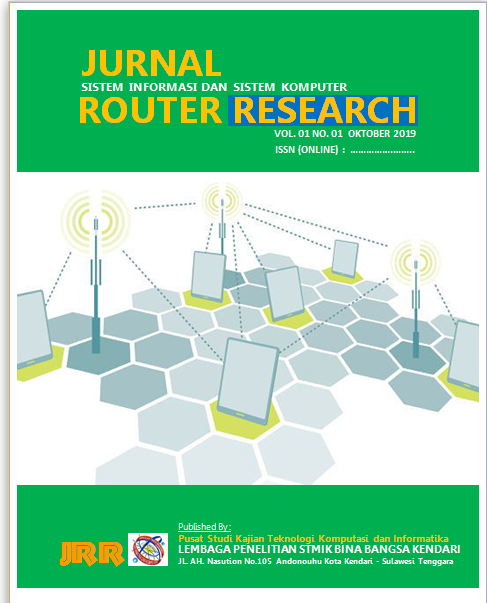Full Length Articles
Penerapan Data Mining untuk Identifikasi Penyakit Diabetes Melitus dengan Menggunakan Metode Klasifikasi☆
Highlights
Generate NLP AI by Wizdam ID.
Abstract
Penyakit Diabetes Melitus (DM) dengan komplikasi merupakan penyebab tertinggi kematian ketiga di indonesia yang setiap tahun penderitanya semakin bertambah, penyakit ini dulunya di juluki penyakit orang kaya namun seiring bertambahnya waktu penyakit ini sudah diidap oleh masyarakat menengah dan miskin. Hal ini dikarenakan bukan lagi karena faktor genetic tapi pola hidup yang tidak teratur menjadi penyumbang pesatnya penyakit ini, berdasarkan data WHO 80% penderita DM dapat dicegah, Klasifikasi pada penelitian ini bertujuan untuk memudahkan perawat dan penderita mengenali tipe penyakit DM agar penanganan penyakit diabetes semakin mudah dilakukan. Untuk menghasilkan informasi baru maka digunakan perhitungan algoritma C.45 dan pengujian algoritma yang menggunakan aplikasi rapid miner akan semakin memperkuat keputusan. Pada pengujian penelitian ini menggunakan beberapa atribut klasifikasi yakni atribut Jenis Kelamin, berat badan,Usia, Perokok, kadar gula darah, dan Tipe penyakit diabetes. Semua atribut tersebut akan dijadikan acuan dalam penelusuran hasil sehingga perawat dan penderita dapat menjadikan acuan dalam perawatan diri pasien secara optimal.
Keywords
Introduction
Section snippets
Material and Methods
Materials and methods from the full-text PDF of this article cannot be displayed.
Results
Results from the full-text PDF of this article cannot be displayed.
Discussion
Discussion from the full-text PDF of this article cannot be displayed.
Conclusions
Conclusions from the full-text PDF of this article cannot be displayed.
Acknowledgment
Acknowledgment from the full-text PDF of this article cannot be displayed.
Funding Information
Program Studi Sistem Komputer Stimik Bina Bangsa Kendari
Competing interest
The authors declare that they have no known competing financial interests or personal relationships that could have appeared to influence the work reported in this paper.
Conflict of interest
The authors declare that the research was conducted in the absence of any commercial or financial relationships that could be construed as a potential conflict of interest.
Ethical approval acknowledgements
No ethical approval required for this article. All procedures followed were in accordance with the ethical standards of the responsible committee on human experimentation (institutional and national) and with the Helsinki Declaration of 1975, as revised in 2008 (5)
Supplementary files
Data sharing not applicable to this article as no datasets were generated or analysed during the current study, and/or contains supplementary material, which is available to authorized users.
References (1)
Anik andriani, sistem prediksi penyakit diabetes berbasis decision tree, Jurnal bianglala informatika, vol 1 no 1 september 2013.
Devi, M. R., & Shyla, J. M. (2016). Analysis of various data mining techniques to predict diabetes mellitus. International Journal of Applied Engineering Research, 11(1), 727-730.
Fernanda, J. W., & Otok, B. W. (2012). Boosting Neural Network dan Boosting Cart Pada Klasifikasi Diabetes Militus Tipe II. Jurnal Matematika, 2(2), 1693-1394.
Oktiandi nugroho, bagus adhi kusuma, zanuar rifai, tri astuti, uswatun khasanah, risky wahyudi, peranan data mining untuk mengidentifikasi penyakit diabetes mellitus dengan menggunakan algoritme ID3, ISBN: 978
Poonguzhali ,E., Kabilan,S., Kannan,S., & Sivagami , P. (2014). Diagnosis of Diabetes Mellitus Type2 using Neural Network. International Journal of Emerging Technology and Advanced Engineering, 4(2),939–942
Fahra, R. U., Widayati, N., & Sutawardana, J. H. (2017). Hubungan Peran Perawat Sebagai Edukator Dengan Perawatan Diri Pasien Diabetes Melitus Tipe 2 Di Poli Penyakit Dalam Rumah Sakit Bina Sehat Jember.
Fernanda, S. I., Ratnawati, D. E., & Adikara, P. P. (2017). Identifikasi Penyakit Diabetes Mellitus Menggunakan Metode Modified K-Nearest Neighbor (MKNN). Jurnal Pengembangan Teknologi Informasi dan Ilmu Komputer e-ISSN, 2548, 964X.
Fernanda, S. I., Ratnawati, D. E., & Adikara, P. P. (2017). Identifikasi Penyakit Diabetes Mellitus Menggunakan Metode Modified K-Nearest Neighbor (MKNN). Jurnal Pengembangan Teknologi Informasi dan Ilmu Komputer vol 1 no. 6
Smeltzer, S.C. & Bare, B.G.(Eds) 2002. Buku Ajar Keperawatan Medikal-Bedah Brunner & Suddarth. Ed. 8, Vol. 2. Jakarta: EGC
Sa’di, S., Maleki, A., Hashemi, R., Panbechi, Z., & Chalabi, K. (2015). Comparison of data mining algorithms in the diagnosis of type II diabetes. International Journal on Computational Science & Applications (IJCSA), 5(5), 1-12.
Vijayan, V., & Ravikumar, A. (2014). Study of data mining algorithms for prediction and diagnosis of diabetes mellitus. International journal of computer applications, 95(17), 12-16
Bibliographic Information
Cite this article as:
-
Submitted
16 September 2019 -
Accepted
16 September 2019 -
Published
16 September 2019 -
Version of record
18 September 2019 -
Issue date
31 December 2019
Copyright
Sangia Advertisement
- ☆
Pemrosesan naskah dibawah tanggungjawab Lembaga Penelitian dan Pengabdian pada Masyarakat (LPPM), STIMIK Bina Bangsa Kendari. Edited by Darsilan, SE, M.Si (C). Full-text and the content of it is under responsibility of authors of the article.
- ☆
Pemrosesan naskah dibawah tanggungjawab Lembaga Penelitian dan Pengabdian pada Masyarakat (LPPM), STIMIK Bina Bangsa Kendari. Edited by Darsilan, SE, M.Si (C). Full-text and the content of it is under responsibility of authors of the article.
Copyright © 2019 Faiz Aris, Benyamin Benyamin. Lembaga Penelitian dan Pengabdian pada Masyarakat (LPPM), STIMIK Bina Bangsa Kendari. Production and hosting by Sangia (SRM™).  This work is licensed under a Creative Commons Attribution 4.0 International License.
This work is licensed under a Creative Commons Attribution 4.0 International License.
Disclaimer: All claims expressed in this article are solely those of the authors and do not necessarily represent those of their affiliated organizations, or those of the publisher, the editors and the reviewers. Any product that may be evaluated in this article or claim that may be made by its manufacturer is not guaranteed or endorsed by the publisher.






